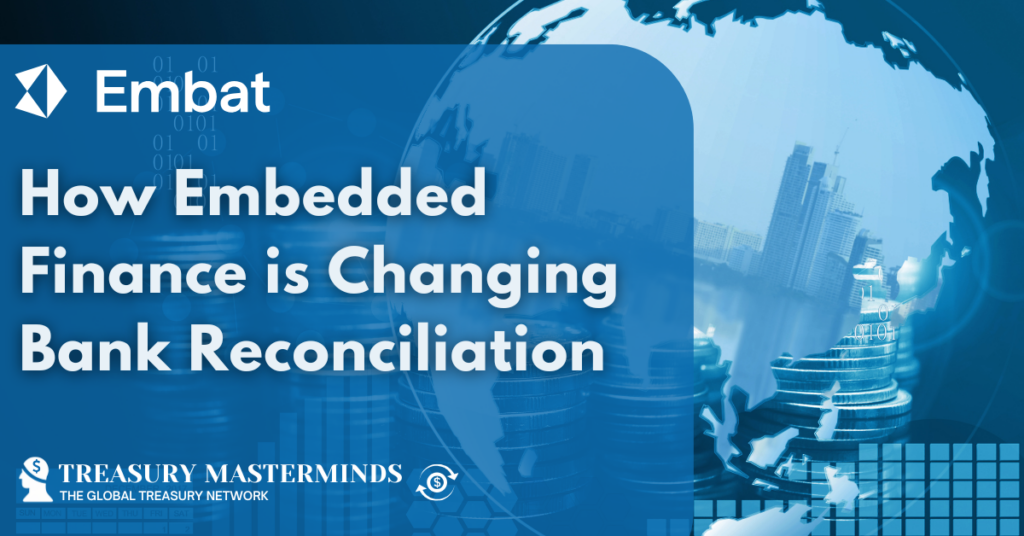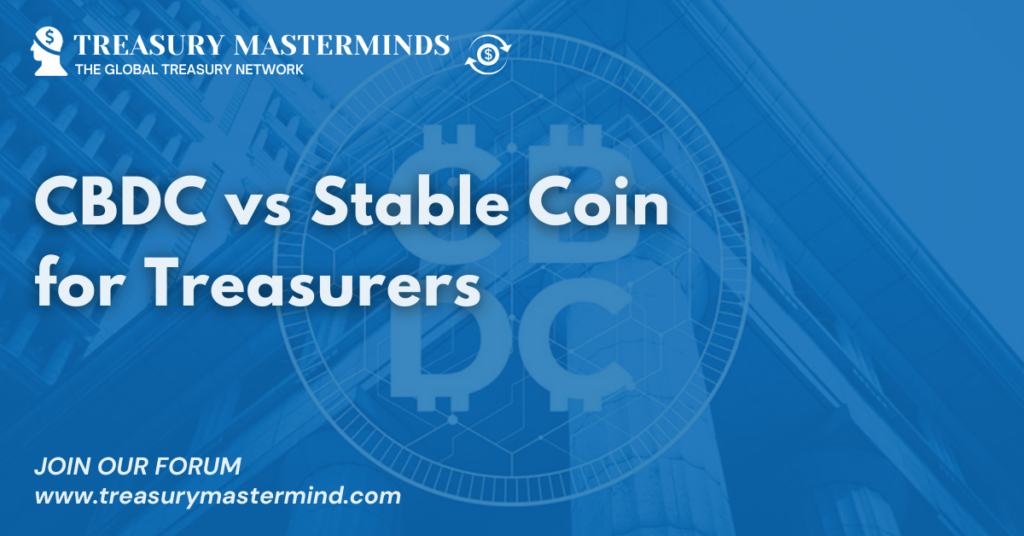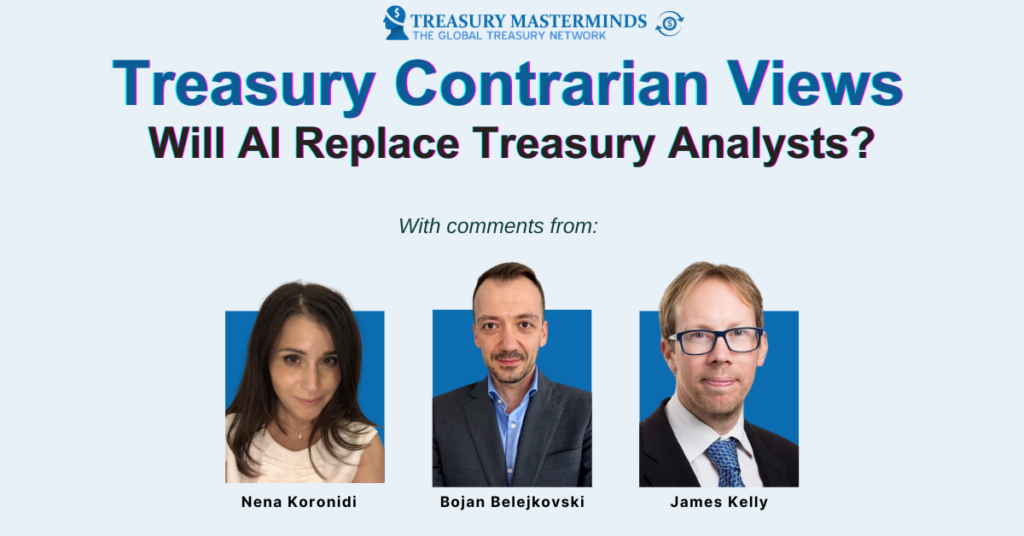
How Embedded Finance is Changing Bank Reconciliation
This article is written by Embat Embedded finance is revolutionising the way businesses and banks interact with each other, as well as with consumers and users. Advances in new technologies and the support of APIs have completely changed the current financial paradigm, altering many of the business processes we encounter daily. But how exactly is such a fundamental process like bank reconciliation changing? What advantages does this new reality bring? Discover more below. What is embedded finance? The term embedded finance refers to the integration of financial services into platforms or applications that traditionally do not belong to the financial sector. In other words, it is the merging of banking and financial services within non-banking applications, allowing these applications to offer services such as payments, loans and insurance more directly to their users. The idea behind embedded finance is not entirely new. For years, companies have sought ways to simplify the user experience by reducing friction in their payment processes. However, with technological evolution and the emergence of fintech, this integration has become deeper and more diverse. Now, we are not just talking about payments but a complete range of financial services that can be integrated into e-commerce platforms, mobility applications, social networks, and more. Technology has been the catalyst in the rise of embedded finance. Open Banking in general and APIs in particular have allowed non-financial platforms to connect securely with financial service providers. This has democratised access to financial services, enabling companies of all sizes and sectors to offer their customers embedded financial solutions. Advantages of embedded finance for a business The advantages of adopting embedded finance are multiple and can significantly impact a company’s growth and profitability. Below, we explore all these benefits in detail: Advantages for banks Embedded finance is not just an attractive option for businesses. Banks can also benefit from its full potential: APIs & UX Embedded finance could not have reached its peak without the power provided by APIs. Application Programming Interfaces (APIs) are essential within embedded finance, allowing different software to communicate with each other. In the financial context, APIs enable platforms to integrate banking services securely and efficiently. In this regard, UX is also important. A smooth and simple user experience can be the difference between the success and failure of financial service integration. It is essential that transactions are intuitive and that the user feels confident when using these services. Exemplary cases of embedded finance in the world Embedded finance has enabled numerous companies, both within and outside the financial sector, to innovate and offer solutions that were previously unthinkable. These exemplary cases demonstrate the power and potential of integrating financial services into non-traditional platforms: How to implement embedded finance Implementing embedded finance in a company or platform may seem like a complex task, but with proper planning and the right tools, the process can be smooth and effective. Below are the key steps and considerations for successful implementation: Tools for implementing embedded finance A successful implementation of embedded finance requires specialised tools and platforms that facilitate the integration of financial services into non-financial applications and platforms. Some of the most notable tools in this area are: Banking API platforms: Integrated payment solutions Loan-as-a-Service (LaaS) Platforms: At Embat, we have a flexible and customisable automatic reconciliation system. With this solution, you can automate bank reconciliation using criteria tailored to your business’s specific needs. With an agile and intuitive interface and verification and approval processes that ensure traceability and compliance with requirements at all times. Conclusion In conclusion, embedded finance is transforming bank reconciliation and the way businesses and banks interact. With benefits for both businesses and banks, this trend is here to stay and continue revolutionising the financial world. Also Read Join our Treasury Community Treasury Masterminds is a community of professionals working in treasury management or those interested in learning more about various topics related to treasury management, including cash management, foreign exchange management, and payments. To register and connect with Treasury professionals, click [HERE] or fill out the form below. Notice: JavaScript is required for this content.

CBDC vs Stable Coin for Treasurers
The rise of Central Bank Digital Currencies (CBDCs) and stablecoins is a hot topic in the world of treasury and payments, particularly with the push toward faster, more efficient international transactions. Here’s a comparison of CBDCs and stablecoins, focusing on control and their potential usefulness for corporate treasurers: 1. CBDCs (Central Bank Digital Currencies) CBDCs are digital versions of a country’s fiat currency, issued and regulated by central banks. They’re essentially a government-backed digital asset, often with the same legal status as physical cash. Key Aspects: Usefulness for Corporate Treasurers: Challenges for Treasurers: 2. Stablecoins Stablecoins are digital currencies designed to maintain a stable value by being pegged to an underlying asset (like a US dollar, gold, or a basket of assets). They’re typically issued by private companies rather than central banks. Key Aspects: Usefulness for Corporate Treasurers: Challenges for Treasurers: Comparison of CBDCs vs Stablecoins for Corporate Treasurers Feature CBDCs Stablecoins Control High (centralized control by govts) Low (private issuers or decentralized) Stability Very high (tied to national currency) High (tied to fiat currency, gold, or basket of assets) Regulation Strong government oversight Varied (some issuers may be subject to regulations, but not by central governments) Use for Cross-Border Payments Potentially faster and cheaper than traditional banking, but may face issues of interoperability Faster, cheaper, and decentralized cross-border payments with fewer intermediaries Liquidity Management Allows treasury to manage cash within a highly stable framework Allows treasury to manage liquidity with some flexibility, especially if there’s a stable backing asset Risk Management Limited risk exposure (depends on gov’t policy) Potentially higher risk exposure (issuer solvency, regulatory risks) Conclusion: For corporate treasurers, both options hold potential, but each comes with its own set of risks and challenges. The key will be closely monitoring the regulatory landscape and adoption trends as these technologies continue to evolve. Also Read Join our Treasury Community Treasury Mastermind is a community of professionals working in treasury management or those interested in learning more about various topics related to treasury management, including cash management, foreign exchange management, and payments. To register and connect with Treasury professionals, click [HERE] or fill out the form below to get more information. Notice: JavaScript is required for this content.

Are You Checking Your FX Trade Time-stamps?
This article is a contribution from our content partner, Just The UK Financial Conduct Authority (FCA) has released a statement confirming its recognition of the updated FX Global Code. As part of that statement, the FCA also clarified its view that it is not consistent with the principles in the Code for FX providers to delay a client’s trade request beyond the time needed to complete price and validity checks as part of a “last look policy” in order to see if future price changes would increase FX provider margins. Specifically, the FCA stated, “Market participants should not prolong the duration of the last look window for the purpose of seeing if future prices move in their favour in relation to the client’s trade request.” This kind of practice has occurred in the marketplace and has meant that companies have paid unfair prices for their FX trades. An example of a particularly egregious abuse of this practice was the recent case in the U.S. where Wells Fargo was fined 72.6 million USD for unfair and fraudulent FX practices, which included delaying a client’s trade execution to find a price that better suited its margins. These practices also highlight why it is important to pay attention to timestamps that relate to when a trade is ordered and when it is executed. What is the FX Global Code and what does it say about time-stamps? The FX Global Code was developed as an effort between central banks market participants in 20 jurisdictions around the globe to promote principles of good practices in the wholesale foreign exchange market. The FX Global Code addresses time-stamps, and was written “to apply to all FX Market Participants that engage in the FX Markets, including sell-side and buy-side entities, non-bank liquidity providers, operators of FX E-Trading Platforms, and other entities providing brokerage, execution, and settlement services.” According to Principle 36 in the FX Global Code, “Market Participants should apply sufficiently granular and consistent time-stamping so that they record both when an order is accepted and when it is triggered/executed… Information should be made available to Clients upon request, to provide sufficient transparency regarding their orders and transactions to facilitate informed decisions regarding their market interactions.” You can search whether your FX provider has signed up to the code here. Detailed time-stamps on FX trade confirmation receipts help protect corporate FX customers A key part of controlling corporate FX costs and managing corporate FX is ensuring that trades are executed in a timely manner in alignment with customer agreements and expectations. This is why it is particularly important for corporate FX customers to ensure that their FX provider is including the trade execution time-stamp in the receipts confirming their trades. The trade execution timestamp is information corporate FX customers have a right to view, but some FX providers exclude this information unless specifically requested by the customer. FX providers should also provide the time-stamps with sufficient detail, such as including the seconds (and not just the minute) in the time-stamps they provide, and also making clear the timezone. In a previous Just FX Blog, we have provided further detail for corporate FX customers on how to review trade confirmation receipts. Time-stamps on FX trade confirmation receipts give corporate customers the power to get fair rates and fair margins By checking trade confirmation receipts to review the time-stamps, corporate FX customers can monitor whether trades were completed in a timely manner and whether they received the prices they expected. It also enables customers to check whether they received fair rates through a process known as FX benchmarking, as the time-stamp is critical for such analysis. In a related Just FX Blog, we explain the importance and process of FX Benchmarking. Also Read Join our Treasury Community Treasury Masterminds is a community of professionals working in treasury management or those interested in learning more about various topics related to treasury management, including cash management, foreign exchange management, and payments. To register and connect with Treasury professionals, click [HERE] or fill out the form below. Notice: JavaScript is required for this content.

Dynamic Discounting
This article is a contribution from our content partner, PrimeTrade Dynamic discounting is a form of supplier finance – often grouped with supply chain finance, SCF, and reverse factoring. These are arrangements that help suppliers to get cash early when buyers do not want to pay invoices immediately. Dynamic discounting is different though Supply chain finance uses an external financier to bridge the time gap between when the supplier wants the cash (now) and when buyer wants to pay (later). In dynamic discounting, the buyer uses its own money, pays the invoice early and gets a discount. Really? Yes – the buyer first negotiates a payment delay with the supplier (e.g., 90 days) and then, for a discount, pays the supplier more quickly. But why not just pay more quickly from the start? There can be a buyer benefit. Typically the buyer team that places orders with suppliers and negotiates prices (“Procurement”) is not the team that manages the buyer’s cash (“Treasury”) and who can price the benefit of early payments. Splitting the negotiation into two separate conversations can benefit the buyer. “Dynamic discounting” can be dynamic. First, procurement teams require suppliers to accept deferred payment terms (e.g., 90 days delay). Second, in many cases, suppliers who want cash early bid for it from the Buyer’s treasury team. The higher the bid, the more likely the supplier will get the money and the bigger the return earned by the Buyer. Using an auction can maximise the buyer’s return on their money. Is there a catch? We think that dynamic discounting is not helpful for suppliers. There’s no guarantee on the cost and availability of early payments. If suppliers have to bid each time, they might win, or they might lose. This leads to financial stress for suppliers. Suppliers have costs to meet (e.g., payroll) and often no choice on financing. Dynamic discounting can offer the worst of all worlds, leading to uncertainty, risk, and cost for the supplier, which ultimately will be included in the price they charge the buyer. Should dynamic discounting be not dynamic? In most platforms, enabling supplier discounts to be dynamic is straightforward. But we recommend making supplier financing simple and “static.” The benefit generated by squeezing the last bit of margin out of suppliers is typically more than offset by the uncertainty that suppliers can experience. How might static work efficiently? What’s needed is a way to guarantee liquidity at a sensible price whilst still enabling the buyer to book a return. There are three innovations here: Take these three points together, and you can have the best of all worlds. Buyers get to maximise their earnings on all the supplier finance arranged – using their own cash and via funding provided direct to suppliers, all in one program. And suppliers get certainty on the cost and availability of early payments. Dynamic discounting that is a bit less dynamic. Also Read Join our Treasury Community Treasury Masterminds is a community of professionals working in treasury management or those interested in learning more about various topics related to treasury management, including cash management, foreign exchange management, and payments. To register and connect with Treasury professionals, click [HERE] or fill out the form below. Notice: JavaScript is required for this content.

Treasury Contrarian View: Will AI Replace Treasury Analysts?
With the rise of artificial intelligence (AI) and automation, corporate treasury is experiencing a technological transformation. AI-driven forecasting, reconciliations, and fraud detection are becoming more advanced. But does this mean that the role of treasury analysts will soon be obsolete? Or is AI simply another tool to enhance efficiency rather than replace human expertise? The Case for AI Taking Over Treasury Analyst Roles The Case for Treasury Analysts Staying Relevant The Future: AI as an Assistant, Not a Replacement Rather than eliminating treasury analyst roles, AI is more likely to redefine them. The future of treasury will involve: Let’s Discuss We’ll be sharing insights from treasury leaders and industry experts—join the conversation and share your perspective! COMMENTS Nena Koronidi, Treasury Masterminds board member, comments: AI will not replace treasury analysts; it will enhance their efficiency. Rather than spending hours in repetitive tasks, young treasury teams have the opportunity to focus on developing their decision-making and analytical skills much earlier in their careers. Instead of spending countless hours on data crunching and spreadsheets, they can focus on risk analysis and risk assessment and collaborating with senior members of the team to interpret the insights, ultimately becoming more valuable assets to the team. The transactional treasury role is long gone; this time, young treasury teams will be the ones driving the change. Bojan Belejkovski, Treasury Masterminds board member, comments: The future isn’t AI vs. Treasury teams—it’s treasury utilizing AI to drive better insights, efficiency, and value creation. Treasury teams that embrace AI as a tool, rather than a threat, will be best positioned for success. While AI enhances forecasting, risk management, and general automation, it lacks the human judgment needed for strategic decision-making, relationship management, and navigating complex regulations specific to an organization. Treasury is more than just data processing; it requires business acumen, adaptability, and financial expertise. James Kelly, Treasury Masterminds board member, comments: If all you do is press buttons, be worried. If you’re curious, open minded and collaborative you’ll always have a role AI opens the door to fixing the gaps in systems that have required a lot of manual intervention. Many of these vary from company to company and so require a degree of problem solving and creativity, but doing so will allow more time for strategy and supporting the business AI only works off historic data and so will not be able to accurately predict in the event of a major shock which would require human judgement Equally an AI-only treasury future is also a more unstable future – imagine if all were trained to fully draw loan facilities in the event of market disruption, we’d see more bank runs. AI also makes errors and so again imagine if a major trade was entered incorrectly- it may result in a loss for that company but may also trigger disruption in the market. A skilled analyst knows not to trade $200m via a trading portal asking 10 banks – AI may not AI isn’t homogenous. There will be well trained effective AI and bad AI. At this stage we don’t yet know if good AI will eventually be able to replace analysts entirely – at present it can’t as the error/hallucination rate is way too high and we don’t know if all the data silo challenges can be resolved (which will probably vary by company), and that’s before thinking about the people side of things. Because people don’t make decisions solely based on data – data informs decisions but people make decisions based on emotion and connections. Also Read Join our Treasury Community Treasury Mastermind is a community of professionals working in treasury management or those interested in learning more about various topics related to treasury management, including cash management, foreign exchange management, and payments. To register and connect with Treasury professionals, click [HERE] or fill out the form below to get more information. Notice: JavaScript is required for this content.

FX: Is Hedging Expensive?
This article is a contribution from one of our content partners, Bound The myth of hedging costs Maybe the title of this section gives away my conclusion, but here we go. Foreign exchange volatility can mess up any company’s financials. Companies not wanting to be held hostage by FX should consider hedging—i.e., taking the volatility from FX out of their finances. What I keep hearing though is that hedging is expensive. So let’s attempt to drill down into the costs of hedging versus executing foreign exchange transactions via spot conversions. It’s important to note that the specific components of hedging costs can vary based on the type of financial instruments being used, the markets involved, and the strategies employed. The below focuses on standard hedges via forwards and other vanilla instruments. Transaction Costs These are the direct costs incurred when executing a hedge, such as provider fees, commissions, and any other fees associated with trading financial instruments. In our experience, hedging instruments are a few basis points (1 basis point = 0.01%) more expensive than spot, but in most cases well below 1% (unless you hedge with your bank and have not negotiated, or there are implications for margin postings). Bid-Ask Spread The bid-ask spread is the difference between the buying (bid) and selling (ask) prices of a financial instrument. In the Interbank Market for major currency pairs, these tend to be marginal for forwards—think single-digit basis points or even fractions of a basis point. Spot transactions also have bid-ask spreads, so this doesn’t usually make hedging much more expensive than spot. Margin If a hedge involves trading on margin, there may be interest costs associated with borrowing funds to support the margin position. Margin tends to be more of a cash flow issue rather than an actual cost for most companies. Slippage Slippage occurs when the execution price of a trade differs from the expected price. This can happen in fast-moving markets or due to low liquidity. Slippage costs can contribute to overall hedging expenses, but this is usually for very large transactions or if transacting in very illiquid currencies. Most company’s hedging transactions will fall well below the threshold where slippage applies if transacting in major currencies. Time Time can be a major factor to impact your hedging costs. It depends on the solutions implemented and how they are dealt with, though, and luckily there are providers out there that are very easy to implement and offer flexibility to adjust hedges. Here is how I think about the time commitment buckets for hedges: Exposure and Hedge Modeling Costs If complex financial models or derivatives are used for hedging, there may be costs associated with developing and implementing these models. This can be mitigated by simplified exposure calculations and easy-to-implement and monitor hedges such as forward contracts. Once a company knows the exposure and has a hedging strategy, with solutions such as Bound, time commitment is similar to the execution of a spot. Maintenance Costs The ongoing monitoring and management of a hedge position may involve additional time. This includes the costs associated with adjusting the hedge to maintain its effectiveness over time. Again, if implemented via a self-service platform, the time commitment is down to a similar amount a company would spend on ad hoc spot transactions. Reporting Costs: Compliance with regulatory requirements and the associated reporting and documentation procedures can contribute to the overall cost of hedging. Conclusion If summing up all the potential costs of hedging versus spot, we are talking about basis points rather than percentages. On the flipside, FX markets tend to move in multiple percentage points and that volatility then goes through a company’s financials. So the costs versus benefits are very limited—not enough as an excuse not to hedge. This assumes that a company is not in the business of speculating in foreign exchange, as markets can go up as well as down. Just be aware that FX is one of the most traded capital markets and the larger players tend to be professional investors and institutions whose day job it is to trade these instruments. Recommended Reading Join our Treasury Community Treasury Masterminds is a community of professionals working in treasury management or those interested in learning more about various topics related to treasury management, including cash management, foreign exchange management, and payments. To register and connect with Treasury professionals, click [HERE] or fill out the form below. Notice: JavaScript is required for this content.

Treasury needs to be it’s own DOGE
Written by Patrick Kunz 1. Treasury as the “DOGE” of the Organization Just like the Department of Governmental Efficiency (DOGE) would aim to streamline spending, eliminate waste, and optimize financial processes in government, corporate treasurers play the same role within a company: Corporate treasurers are, in a sense, the “DOGE” of the company—watchdogs of financial efficiency. 2. Tracking Spending in Real-Time: Treasury’s Version of Blockchain Auditing A key function of DOGE (the department, not the coin) would be real-time tracking of government expenditures to improve transparency and accountability. Treasury teams are moving in a similar direction with: If governments implement real-time spending oversight, treasurers may be expected to push for greater financial visibility and accountability within corporations as well. 3. Liquidity Optimization: Learning from Government Cash Management Governments often have massive cash balances tied up in inefficient accounts, just as companies may hold idle cash that isn’t working for them. DOGE could push treasury teams to double down on liquidity strategy to ensure companies aren’t “sitting on cash” while paying unnecessary borrowing costs. 4. Eliminating Redundant Bureaucracy vs. Simplifying Treasury Operations Government inefficiencies often come from too many layers of approval, redundant processes, and slow decision-making. The same can be true in corporate treasury, where: DOGE’s mission to streamline government processes mirrors the ongoing push for simpler, leaner, and more automated treasury operations. 5. The Consequences of Bad Policy Decisions: Government vs. Corporate Treasury A well-run DOGE would highlight the importance of risk-aware financial management, something that treasurers already focus on. Final Thought: Treasury Needs Its Own DOGE If a Department of Governmental Efficiency were created to rein in spending and optimize financial decision-making, treasurers should ask: A well-structured treasury function is already the DOGE of the company, ensuring financial resources are used effectively, risks are managed properly, and liquidity is optimized. Would you like to explore how corporate treasurers could proactively implement DOGE-inspired efficiency strategies within their own organizations? Also Read Join our Treasury Community Treasury Mastermind is a community of professionals working in treasury management or those interested in learning more about various topics related to treasury management, including cash management, foreign exchange management, and payments. To register and connect with Treasury professionals, click [HERE] or fill out the form below to get more information. Notice: JavaScript is required for this content.

KYC is Outdated. It’s Time for Know-Your-Counterparty (KYCp)
This article is a contribution from one of our content partners, Avollone We really should rename KYC from Know-Your-Customer to Know-Your-Counterparty. Until now, various KYC software suppliers have used KYB (Know-Your-Business) to cater to use cases that go beyond knowing your customers. But one should think that customers are your business as well? Obviously, KYB could also cover any due diligence on legal entities, and KYC could cover due diligence on private individuals. However, most companies also have customers who are legal entities, so this is not perfect either. The problem is that the number of use cases for KYC has exploded over recent years, making Know-Your-Customer a rather slim way of describing a broad range of examples of KYC collection and screening. To mention a few use cases we see in Avallone: Looking at the examples above, it becomes clear that KYC is so much more than Know-Your-Customer – and it should be, as the global risk landscape continues to evolve and companies become increasingly aware of the compliance and reputation risks they have to mitigate. On that note – half of our customers are not regulated. Then why bother collecting KYC and performing screening at all? The answer is to protect against reputation risks and non-compliance related to sanctions breaches. When it comes to sanctions, everyone is regulated, after all. I know I sound like an old compliance officer trying to convince the business to do more (or a KYC software CEO trying to sell more), but being really great at KYC and sanctions screening is a competitive advantage these days. Funds that are super good at screening their investment targets will attract more funding because investors do not want to support financial crime. Blue-chip corporations are more inclined to buy CO2 emissions certificates when they are sure the money will not be used in a money laundering scheme. Law firms with a super tight process when collecting KYC from their clients just get more clients, as everyone hates KYC and just wants it to be fast and painless. The list goes on. Also Read Join our Treasury Community Treasury Masterminds is a community of professionals working in treasury management or those interested in learning more about various topics related to treasury management, including cash management, foreign exchange management, and payments. To register and connect with Treasury professionals, click [HERE] or fill out the form below. Notice: JavaScript is required for this content.

Measuring currency risks—what is behind CFaR and its cousins
This article is written by HedgeFlows Quantifying FX risk is one of the most challenging aspects of foreign exchange risk management. To determine whether managing currency risk is worthwhile, it’s essential to understand exactly what you’re protecting against. This knowledge is key to making informed decisions. While large multinational corporations often rely on concepts like Value at Risk (VaR), Cash Flow at Risk (CFaR), or Earnings at Risk (EaR) through their dedicated treasury or risk departments, these tools are less familiar and uncommon for smaller businesses with leaner finance teams. This article dives into the theory behind risk metrics and explains how to use them. Making sense of randomness Measuring FX risks is based on the notion that exchange rates move randomly over time and the changes in the value of currencies over a specific period of time have different likelihoods. This likelihood is distributed in a manner close to a normal distribution. For example, the graph below shows the historical distribution of 90-day moves of the Pound Sterling vs the US Dollar (grey) and its modelled distribution, which is normally distributed. As one can see, most potential outcomes are small moves clustered around zero, but in rare outcomes, the exchange rate moved more than 20% over 90 days. Asking the right question So, what is the right measure to use in order to quantify FX risks in a small business? It depends on what you want and what you’re trying to answer. In FX risk management, there is a big difference between asking the question, “What is the maximum I could lose due to foreign exchange?” and “What could I potentially lose on foreign exchange?” The former question emphasises the risks posed by rare but often catastrophic events – situations that occur infrequently yet have significant consequences when they do. These are the kinds of events that make headlines and can push businesses to the brink of collapse. Take, for instance, the aftermath of the Brexit vote, which triggered a sharp decline in the value of the Pound Sterling, or the more recent crisis during Liz Truss’ government, which temporarily plunged the Pound to multi-decade lows. Such events are notoriously hard to predict and, as a result, are not typically reflected in prevailing exchange rates. When they do occur, however, they can cause sudden and extreme market volatility, leading to lasting financial damage. Tools like Value-at-Risk, Cashflows-at-Risk, or Earnings-at-Risk are specifically designed to measure and account for these risks. However, because these moves are so rare, many businesses often ignore them until they have a real impact and become a topic of purposeful discussion. Hence, while knowing the maximum potential loss is essential, many CFOs are often more interested in more likely potential outcomes that can still have an impact on their business. The stability of cash flows or profit margins is often an implicit or explicit hedging objective, and even a 5% FX move can often have a sizeable impact on one’s cashflows. Because moves of such magnitude are a lot more likely to happen, it is not surprising that the jump in likelihood often makes such potential moves a lot more “real” to CFOs and their teams, and this is easier to relate to and thus manage. For example, as shown on the graph below, the likelihood of an FX move of 4% or greater is 20 times higher (probability of 20%) than that of 14.5% (probability of 1%). Different risks but the same solution Select the risk metric that best aligns with your business objectives and feels most intuitive to your needs. Fortunately, for most companies, this decision won’t affect the overall solution. FX forwards continue to be the preferred hedging instrument. You may have noticed that we refer to more minor, more probable outcomes as a move of “X% or greater.” This phrasing reflects that these outcomes represent not a specific point but a range of possibilities (losses) that extend beyond that threshold. If you choose to mitigate these risks, you will also reduce risks of larger, less probable outcomes. If, for example, you decide to hedge 50% of your exposure with FX forwards, the potential losses will halve, no matter which risk metric you choose. Also Read Join our Treasury Community Treasury Masterminds is a community of professionals working in treasury management or those interested in learning more about various topics related to treasury management, including cash management, foreign exchange management, and payments. To register and connect with Treasury professionals, click [HERE] or fill out the form below to get more information. Notice: JavaScript is required for this content.